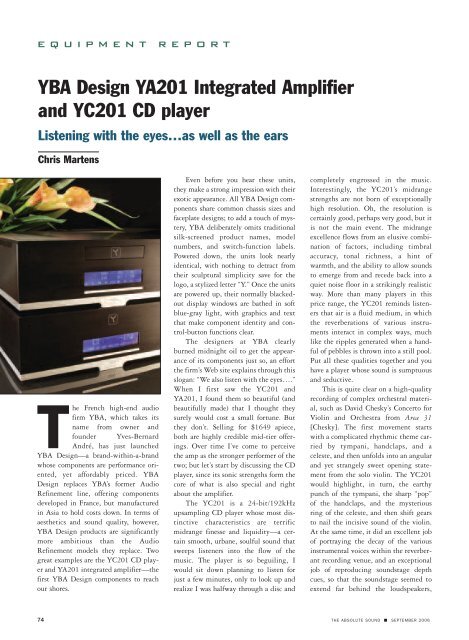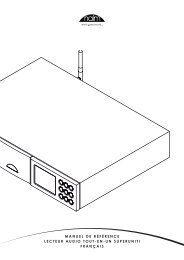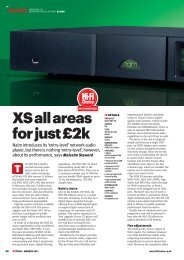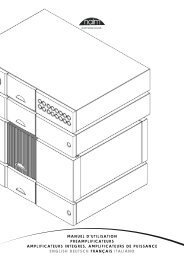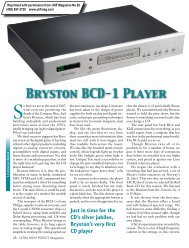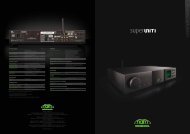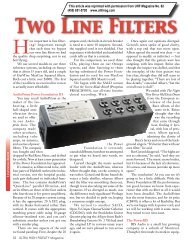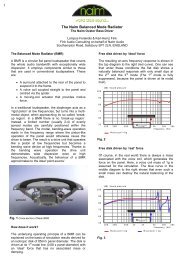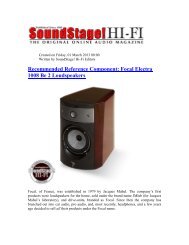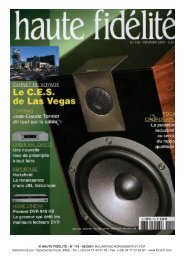YBA Design YA201 Integrated Amplifier and YC201 CD player
YBA Design YA201 Integrated Amplifier and YC201 CD player
YBA Design YA201 Integrated Amplifier and YC201 CD player
Create successful ePaper yourself
Turn your PDF publications into a flip-book with our unique Google optimized e-Paper software.
equipment<br />
report<br />
<strong>YBA</strong> <strong>Design</strong> <strong>YA201</strong> <strong>Integrated</strong> <strong>Amplifier</strong><br />
<strong>and</strong> <strong>YC201</strong> <strong>CD</strong> <strong>player</strong><br />
Listening with the eyes…as well as the ears<br />
Chris Martens<br />
The French high-end audio<br />
firm <strong>YBA</strong>, which takes its<br />
name from owner <strong>and</strong><br />
founder Yves-Bernard<br />
André, has just launched<br />
<strong>YBA</strong> <strong>Design</strong>—a br<strong>and</strong>-within-a-br<strong>and</strong><br />
whose components are performance oriented,<br />
yet affordably priced. <strong>YBA</strong><br />
<strong>Design</strong> replaces <strong>YBA</strong>’s former Audio<br />
Refinement line, offering components<br />
developed in France, but manufactured<br />
in Asia to hold costs down. In terms of<br />
aesthetics <strong>and</strong> sound quality, however,<br />
<strong>YBA</strong> <strong>Design</strong> products are significantly<br />
more ambitious than the Audio<br />
Refinement models they replace. Two<br />
great examples are the <strong>YC201</strong> <strong>CD</strong> <strong>player</strong><br />
<strong>and</strong> <strong>YA201</strong> integrated amplifier—the<br />
first <strong>YBA</strong> <strong>Design</strong> components to reach<br />
our shores.<br />
Even before you hear these units,<br />
they make a strong impression with their<br />
exotic appearance. All <strong>YBA</strong> <strong>Design</strong> components<br />
share common chassis sizes <strong>and</strong><br />
faceplate designs; to add a touch of mystery,<br />
<strong>YBA</strong> deliberately omits traditional<br />
silk-screened product names, model<br />
numbers, <strong>and</strong> switch-function labels.<br />
Powered down, the units look nearly<br />
identical, with nothing to detract from<br />
their sculptural simplicity save for the<br />
logo, a stylized letter “Y.” Once the units<br />
are powered up, their normally blackedout<br />
display windows are bathed in soft<br />
blue-gray light, with graphics <strong>and</strong> text<br />
that make component identity <strong>and</strong> control-button<br />
functions clear.<br />
The designers at <strong>YBA</strong> clearly<br />
burned midnight oil to get the appearance<br />
of its components just so, an effort<br />
the firm’s Web site explains through this<br />
slogan: “We also listen with the eyes….”<br />
When I first saw the <strong>YC201</strong> <strong>and</strong><br />
<strong>YA201</strong>, I found them so beautiful (<strong>and</strong><br />
beautifully made) that I thought they<br />
surely would cost a small fortune. But<br />
they don’t. Selling for $1649 apiece,<br />
both are highly credible mid-tier offerings.<br />
Over time I’ve come to perceive<br />
the amp as the stronger performer of the<br />
two; but let’s start by discussing the <strong>CD</strong><br />
<strong>player</strong>, since its sonic strengths form the<br />
core of what is also special <strong>and</strong> right<br />
about the amplifier.<br />
The <strong>YC201</strong> is a 24-bit/192kHz<br />
upsampling <strong>CD</strong> <strong>player</strong> whose most distinctive<br />
characteristics are terrific<br />
midrange finesse <strong>and</strong> liquidity—a certain<br />
smooth, urbane, soulful sound that<br />
sweeps listeners into the flow of the<br />
music. The <strong>player</strong> is so beguiling, I<br />
would sit down planning to listen for<br />
just a few minutes, only to look up <strong>and</strong><br />
realize I was halfway through a disc <strong>and</strong><br />
completely engrossed in the music.<br />
Interestingly, the <strong>YC201</strong>’s midrange<br />
strengths are not born of exceptionally<br />
high resolution. Oh, the resolution is<br />
certainly good, perhaps very good, but it<br />
is not the main event. The midrange<br />
excellence flows from an elusive combination<br />
of factors, including timbral<br />
accuracy, tonal richness, a hint of<br />
warmth, <strong>and</strong> the ability to allow sounds<br />
to emerge from <strong>and</strong> recede back into a<br />
quiet noise floor in a strikingly realistic<br />
way. More than many <strong>player</strong>s in this<br />
price range, the <strong>YC201</strong> reminds listeners<br />
that air is a fluid medium, in which<br />
the reverberations of various instruments<br />
interact in complex ways, much<br />
like the ripples generated when a h<strong>and</strong>ful<br />
of pebbles is thrown into a still pool.<br />
Put all these qualities together <strong>and</strong> you<br />
have a <strong>player</strong> whose sound is sumptuous<br />
<strong>and</strong> seductive.<br />
This is quite clear on a high-quality<br />
recording of complex orchestral material,<br />
such as David Chesky’s Concerto for<br />
Violin <strong>and</strong> Orchestra from Area 31<br />
[Chesky]. The first movement starts<br />
with a complicated rhythmic theme carried<br />
by tympani, h<strong>and</strong>claps, <strong>and</strong> a<br />
celeste, <strong>and</strong> then unfolds into an angular<br />
<strong>and</strong> yet strangely sweet opening statement<br />
from the solo violin. The <strong>YC201</strong><br />
would highlight, in turn, the earthy<br />
punch of the tympani, the sharp “pop”<br />
of the h<strong>and</strong>claps, <strong>and</strong> the mysterious<br />
ring of the celeste, <strong>and</strong> then shift gears<br />
to nail the incisive sound of the violin.<br />
At the same time, it did an excellent job<br />
of portraying the decay of the various<br />
instrumental voices within the reverberant<br />
recording venue, <strong>and</strong> an exceptional<br />
job of reproducing soundstage depth<br />
cues, so that the soundstage seemed to<br />
extend far behind the loudspeakers,<br />
74 THE ABSOLUTE SOUND ■ SEPTEMBER 2006
equipment<br />
report<br />
almost making me feel as though I could<br />
get up from my chair <strong>and</strong> walk out into<br />
the stage.<br />
My favorable assessment was tempered<br />
by two small but noticeable sonic<br />
shortcomings. First, the <strong>YC201</strong> lacks a<br />
bit of the resolution that today’s best<br />
mid-priced <strong>CD</strong> <strong>player</strong>s achieve. Rega’s<br />
sub-$1000 Apollo, which I had on h<strong>and</strong><br />
for comparison, retrieved significantly<br />
more musically relevant information.<br />
Second, the <strong>YC201</strong> slightly softened<br />
details <strong>and</strong> dynamics at the frequency<br />
extremes—a characteristic that may be<br />
part of the <strong>player</strong>’s almost eerie smoothness,<br />
but that was not, strictly speaking,<br />
accurate. Neither of these is a damning<br />
flaw by any stretch of the imagination,<br />
but together they made me think the<br />
<strong>YC201</strong> was leaving some sonic potential<br />
on the discs unfulfilled.<br />
The <strong>YA201</strong> amplifier is a 100Wpc<br />
solid-state integrated design whose<br />
sonic strengths parallel those of the<br />
<strong>YC201</strong>, but with two important differences.<br />
First, at its best, it offers substantially<br />
more transparency <strong>and</strong> resolution;<br />
second, it delivers crisper response at<br />
upper <strong>and</strong> lower frequency extremes. I<br />
say “at its best,” because the <strong>YA201</strong><br />
could sound almost like two different<br />
amplifiers, depending on playback volume.<br />
At low-to-moderate levels, it<br />
sounded pleasing, but overly polite,<br />
with tone colors that seemed somewhat<br />
washed out. But with the volume turned<br />
up, the amplifier’s character changed<br />
dramatically for the better. With added<br />
volume tone colors became richer <strong>and</strong><br />
more vibrant, <strong>and</strong> instrumental <strong>and</strong><br />
vocal timbres were infused with life.<br />
One recording that crystallized this<br />
impression was Philip Hii’s classical<br />
guitar rendition of the Chopin<br />
Nocturnes [DSG]. At low levels, both<br />
Hii’s guitar <strong>and</strong> the acoustics of the<br />
recording venue sounded flat <strong>and</strong> a bit<br />
like high-end “elevator music.” But<br />
with the volume turned up, the<br />
acoustics of the recording space became<br />
clear <strong>and</strong> the guitar seemed almost eerily<br />
present. Increased volume levels also<br />
made for clearer low-level dynamic<br />
contrasts, <strong>and</strong> an across-the-board<br />
A certain smooth, urbane, soulful sound that<br />
sweeps listeners into the flow of the music<br />
improvement in focus <strong>and</strong> resolution.<br />
As for tonal characteristics, down<br />
low, the <strong>YA201</strong> sounded hearty <strong>and</strong><br />
warm yet clear, though without the last<br />
word in low-frequency transient<br />
response or “traction” (that is, the ability<br />
to control woofers firmly <strong>and</strong> precisely).<br />
Several class D amplifiers I’ve evaluated<br />
lately offer better bass performance<br />
than the <strong>YA201</strong> does, though I<br />
think this amp could hold its own<br />
against like-priced integrated amplifiers<br />
<strong>and</strong> separates (e.g., the NAD C<br />
162/C 272 pair). Highs were delicate,<br />
sweet, <strong>and</strong> pleasantly extended, though<br />
the <strong>YA201</strong> did not provide the razorsharp<br />
treble transient response <strong>and</strong><br />
transparency that some listeners crave<br />
<strong>and</strong> that certain higher-priced amplifiers<br />
deliver. Even so, the <strong>YA201</strong>’s treble<br />
characteristics make it somewhat<br />
forgiving of overly bright associated<br />
components, while still preserving a<br />
healthy measure of clarity.<br />
As with the <strong>YC201</strong>, the broad center<br />
of the midrange is where the <strong>YA201</strong><br />
shines, delineating layers of musical<br />
subtleties in ways that make many midpriced<br />
components sound simplistic.<br />
What makes the <strong>YBA</strong>’s midrange special<br />
is an extraordinary expressiveness. For<br />
example, it reveals how the notes of Paul<br />
Winter’s saxophone on Icarus [Epic, LP]<br />
begin with a rise in pressure at the<br />
mouthpiece, followed by initial bursts of<br />
sound as the reed starts to vibrate, <strong>and</strong><br />
finally bloom as the air column inside<br />
the sax begins to resonate. Granted,<br />
many good integrated amplifiers catch<br />
these distinctions to some degree, but<br />
not with this kind of assuredness on<br />
inner details. This midrange sophistication<br />
<strong>and</strong> richness make the <strong>YA201</strong> an<br />
awful lot of amplifier for the money.<br />
One minor glitch: My review sample<br />
came with faulty control logic, making it<br />
respond to remote control buttons meant<br />
for use with the <strong>YC201</strong> <strong>CD</strong> <strong>player</strong>. <strong>YBA</strong><br />
will probably have this problem straightened<br />
out by the time you read this.<br />
Summing up, <strong>YBA</strong> <strong>Design</strong>’s <strong>YC201</strong><br />
is a lovely <strong>CD</strong> <strong>player</strong> to look at <strong>and</strong> one<br />
blessed with seductive midrange sound.<br />
The only thing holding it from class<br />
leadership is stiff competition from new<br />
mid-priced entries. The <strong>YA201</strong> integrated<br />
amp, on the other h<strong>and</strong>, is a class<br />
leader because it offers the same<br />
midrange magic as the <strong>YC201</strong>, plus<br />
greater transparency <strong>and</strong> better response<br />
at the frequency extremes. Most importantly,<br />
these components convey real<br />
musical joie de vivre.<br />
&<br />
SPECIFICATIONS<br />
<strong>YC201</strong> <strong>CD</strong> <strong>player</strong><br />
Outputs: One stereo analog (RCA), one<br />
digital (coaxial)<br />
Dimensions: 15.35" x 5.1" x 15.35"<br />
Weight: 25.35 lbs.<br />
<strong>YA201</strong> integrated amplifier<br />
Power output: 100 Wpc @ 8 Ohms<br />
Inputs: Six stereo analog (RCA)<br />
Dimensions: 15.35" x 5.1" x 15.35"<br />
Weight: 33.07 lbs.<br />
ASSOCIATED EQUIPMENT<br />
Rega Apollo <strong>CD</strong> <strong>player</strong>; Musical Fidelity<br />
Tri-Vista SA<strong>CD</strong> <strong>player</strong>; Wilson Benesch<br />
Full Circle analog system; Musical<br />
Surroundings Phonomena phonostage;<br />
Epos ELS 303 <strong>and</strong> Paradigm Reference<br />
Signature S8 loudspeakers; RGPC power<br />
conditioner, Cardas interconnect <strong>and</strong><br />
speaker cables<br />
DISTRIBUTOR INFORMATION<br />
AUDIO PLUS SERVICES<br />
156 Lawrence Paquette Industrial Drive<br />
Champlain, New York 12919<br />
(800) 633-9352<br />
ybadesign.com<br />
audioplusservices.com<br />
Prices: $1649 each<br />
76 THE ABSOLUTE SOUND ■ SEPTEMBER 2006


